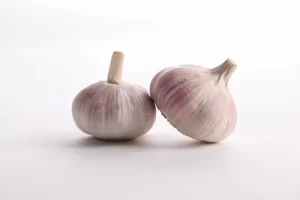Varieties of Chinese Garlic
There are many types of garlic, and according to different division criteria, we can divide garlic into the following types.
1. According to the size, it can be divided into large clove garlic and small clove garlic.
2. According to the color appearance, it can be divided into white garlic and purple garlic. White garlic is naturally white skin with good color brightness and no impurities, so it is considered high-quality white garlic. However, garlic with purple skin is commonly known as “purple-red skin”; if the garlic skin is bright, it is of good quality.
3. According to the number of cloves, garlic can be divided into multi-clove and one-headed garlic. In contrast, common garlic has multiple cloves or multi-clove garlic, and one-headed garlic is a whole and independent clove.
How is garlic grown in china
Soil
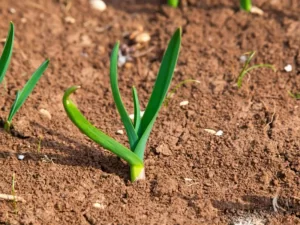
Shandong Jinxiang is a famous garlic planting base in China. The local soil type is tide soil with a medium loam texture, which is very suitable for garlic cultivation. The main characteristics of soil in Jinxiang, China, are
1. The soil is loose, easy to cultivate, and suitable for the growth of root crops.
2. The soil fertility is high after years of fertilization and improvement. According to the laboratory analysis, the pH value of the soil in the 0-20 cm cultivated layer of the farmland in Jinxiang County is 7.0-8.0, a weak alkaline soil.
3. The soil in Jinxiang, China contains a comprehensive range of trace elements such as calcium, magnesium, sodium, manganese, iron, zinc and copper, and all of them are high in content. Therefore, the nutrient-rich soil can effectively promote the normal growth and development of garlic and increase the yield.
| Organic matter content | 1.1%—1.8% |
| Nitrogen alkali digestion | 60—90ppm |
| Fast-acting phosphorus | 15—35ppm |
| Fast-acting potassium | 120—200ppm |
Water sources for irrigation of garlic.
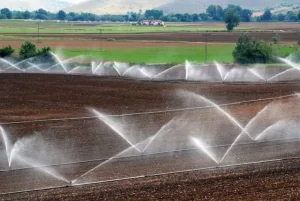
China Jinxiang is rich in groundwater resources, which can fully satisfy garlic irrigation.
Climatic conditions for garlic growth.
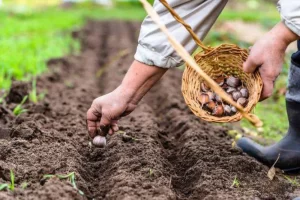
The latitude and longitude of Jinxiang, China is 35°N, 116°E. The climate conditions are ideal for the growth of garlic.
Garlic is suitable for temperatures from 12 to 16°C. We choose the sowing time in early October. If you sow early or late, the garlic is susceptible to temperature fluctuations. If the production period of garlic is shortened, then the yield will be affected.
Process of planting garlic.
The emergence of garlic seedlings in autumn sowing takes about 7~10 days, about 7 days when the conditions are suitable, the specific process.
1. Garlic seedling breeding

①Select robust, white, hard, solid garlic cloves for planting. Before planting, we remove the garlic disc and the outer skin, and then plant into well-watered soil. Plant the garlic at a depth of 3 to 4 cm, with a spacing of about 5 to 1O cm. We have to keep the soil moist. Generally, garlic will germinate in about 1 week’s time.
Note: When planting garlic, the back of each garlic clove should face the same direction so that the leaves grow in basically the same direction after germination.Also if you need to sprout, you can put the garlic cloves in the freezer of the refrigerator and keep them at about 4°C. Just take them out and plant them after sprouting.
②When the seedlings are about 5 cm high, you can follow up with one thinly rotted organic fertilizer, mainly nitrogen fertilizer.
2. Garlic field management
①Garlic is usually watered after the soil surface is slightly dry during the growth period of stems and leaves. This is the only way to avoid garlic rotting due to waterlogging. If garlic shoots and heads are to be harvested, watering should be increased appropriately to keep the soil moist from the start of shoots, and then controlled before harvest.
② Generally, you should follow up with one application of well-rotted organic fertilizer for every harvest of leaves. We can pull out the stems and leaves when they are aging and not suitable for consumption. If we want to harvest garlic shoots and garlic heads then we need to continue normal management and follow up with 1 rotten organic fertilizer every 1 to 2 weeks. Pay attention to increase phosphorus and potassium fertilizer.
3. Harvesting of garlic
When the garlic plant reaches about 20 cm in height, the leaves can be harvested, usually leaving the smaller plants to grow and pulling out the larger ones. You can also cut the plant down with a knife on a sunny day, leaving about 3 to 5 cm on the ground, and dry the cut before managing it normally. For harvesting garlic, dig out the garlic when most of the plant leaves dry naturally and the pseudostems become soft, and dry them in a cool and ventilated place for preservation.
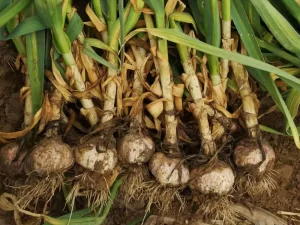
organic garlic
Organic garlic is one of the categories of organic vegetables. The main difference between organic garlic and ordinary garlic is that it is more nutritious than ordinary garlic. Moreover, the planting environment of organic garlic is free from pollution. That is, the whole production process must strictly follow the technical standards of organic food production without the use of pesticides, chemicals and other chemicals. What’s more, the use of genetically engineered ones is not allowed. Also, it must undergo the whole process of quality control and review by an independent organic food certification body.
Is garlic from china safe
The garlic of the world looks at China, and the garlic of China looks at Jinxiang! It can be seen the status of Chinese garlic in the world. 70% of the world garlic market comes from Chinese exports. Chinese garlic is the cleanest and most consistent quality garlic in the world. Every head of Chinese garlic is hand cleaned, selected and graded. Chinese garlic receives more inspection and government regulation than garlic from any other country in the world. Every shipment of exported Chinese garlic is first inspected by Chinese customs. The inspection report is not issued to the exporter until the pesticide residue and pest tests are passed. The ministries of commerce of various countries come to the garlic production area in Jinxiang every year for field inspection of exported garlic. In addition to this, several third-party credible certification agencies in the West have issued quality certificates to companies dealing with garlic in China.

خاتمة
Garlic is almost free from pests. And there is no need for herbicides in China, as weed control and removal is all done by hand! China’s agricultural traditions, small family-owned plots and abundant labor mean that machinery and chemical products are used much less often in garlic cultivation.

